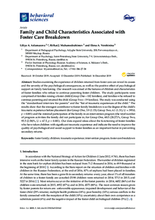Displaying 571 - 580 of 2214
This book outlines narrative and dramatic approaches to improve vulnerable family relationships. It provides a model which offers new ways for parents to practise communicating with their children and develop positive relationships.
This article arises from an EdD thesis (Horsburgh, 2018) that sought to describe research undertaken to address a perceived gap in the literature by carrying out a detailed examination of the classroom learning of seven primary school aged, care‐experienced children.
This randomized control trial aimed to assess how much Teach Your Children Well (TYCW) - a tutoring program that enhances the academic skills of children in care - tutoring is enough to accelerate learning.
Using Swedish registry national data, this study explored the relationship between immigration-country of birth status, psychosocial risk factors, and child compulsory care for parents with risky substance use (RSU).
Using Swedish registry national data, this study explored the relationship between immigration-country of birth status, psychosocial risk factors, and child compulsory care for parents with risky substance use (RSU).
This research was aimed at the features of children and characteristics of foster families who refuse to continue parenting foster children.
This article presents findings and recommendations from the first year of a two-year evaluation of the Local Interagency Network for Children and Family Services (LINCS) program, a part of the Shasta County Department of Social Services in northern California.
This paper from the Australian Institute of Criminology presents selected findings of a detailed case file audit of 300 crossover children (children from child protection backgrounds in the youth justice system) appearing before the Children’s Court of Victoria, Australia in 2016–17.
Drawing on the findings of a Churchill Fellowship study tour, this article discusses the need to expand understanding of family engagement and, in particular, to implement Family Inclusive practice in Australian child welfare, both to increase reunification and to improve outcomes for children who do not return home.
This study aims to develop a Korean out-of-home care satisfaction scale based on questions from the Foster Care Improvements Project.


